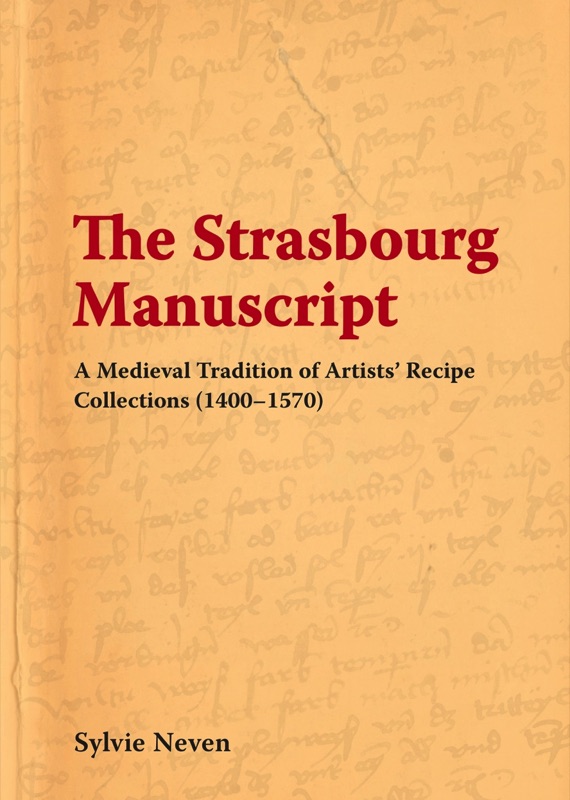This book is the first to be dedicated to a comprehensive study with English translation (plus extensive commentary) of the early 15th century Strasbourg Manuscript - believed to have been the oldest German-language source for the study of Northern European painting techniques and considered to be the northern counterpart to Cennini’s Il Libro dell’arte. It is also one of the oldest technical manuals to include a recipe collection describing the preparation of drying oil media and their application in panel painting.
Lost in a fire at the Strasbourg Library in 1870, this recipe collection was preserved in the only known copy commissioned by Sir Charles Eastlake, the first director of the National Gallery which was partially published in 1847. The author’s extensive research is based on this copy, two later books based on it and also on comparison with other manuscripts of the Strasbourg tradition, that allowed her to reconstruct the text of the lost manuscript.
For a look inside click here.
Introduction
Artists’ recipes as sources for the history of art technology
Diversity, function and reliability of artists’ recipe collections
The Strasbourg Manuscript, a medieval collection of artists’ recipes
Organisation of this book
Chapter 1 The Strasbourg Manuscript
1.1 Discovery and reception
The Strasbourg Library, Ms. A VI 19
The so-called ‘Strasbourg Manuscript’
Referring to the Strasbourg Manuscript: use and abuse
1.2 Former and current form of the Strasbourg Manuscript
The Strasbourg Manuscript within the Ms. A VI 19
The Eastlake copy: structure previously proposed
Re-evaluation of the Eastlake copy
1.3 Restoring the text of the Strasbourg Manuscript
Traditions of artistic recipe collections
Previous identifications of witnesses of the Strasbourg Manuscript text
The recourse to an informatical tool – A database of artists’ recipe collections
List of the manuscripts of the Strasbourg Tradition
The distinct sequences of the Strasbourg Manuscript text
Reconstruction of the former structure
Chapter 2 The Strasbourg Tradition in context
2.1 Transmission of knowledge: the ‘Fachliteratur’
Practical medicine and utilitarian knowledge
Nature, corpus and elements
2.2 Medieval recipe collections: relationship and distinction
Community of practices and materials
The practice and the theory
The recipe: contamination and association
2.3 The genesis and peregrinations of the Strasbourg Tradition
Dates and provenance
Between written and oral transmission: the plurality of sources
Modalities of execution: the copying and compilation process
Authorship, authority and validity
The circulation of the text
Modalities of composition and dissemination: the consequences
Chapter 3 Edition and translation
3.1 Presentation and conventions
A comparative analysis
Terms and terminology used in the English translation
Notes on Eastlake’s translation
Measurements and units
3.2 Edition and translation
Chapter 4 Commentary
161
4.1 Binding media, varnishes and adhesives
Aqueous media
Oil media
Varnishes
4.2 Preparing, refining and tempering colouring materials
Reds
Blues
From red to blue: anthocyanin colourants
Greens
Yellows
Browns
Blacks
4.3 Inks
4.4 Mixtures and modelling
Mixtures: painting in violet and purple
Colours for flourishing
Incompatibilities
Depicting hair
Modelling drapery
Modelling landscape objects
4.5 Use and imitation of gold and silver
Preparation of the gilding ground
Amelioration and imitation : glaze on metal leaf
Gold and silver inks
4.6 Preparation of the supports
Parchment
Horn
Chapter 5 The Strasbourg Manuscript and its Tradition :
original function and current relevance
5.1 Scribes, owners and readers’ interventions
Attempts at facilitating the consultation of the text
Highlighting, completing and correcting the text
Unrelated annotations
5.2. Literary or practical purpose: textual clues
Unintentional variation (I): the lacuna
Unintentional variation (II): the deformation
Intentional variation: the reworked text
5.3 Technicological relevance and specificities
Background of the scribes or authors
The technical specificities of the Strasbourg Manuscript
Localization of the Strasbourg Tradition: some particular illuminating techniques and materials in Medieval South Germany
Appendices
I New edition of the Leiden Vossianus Chymicus octavo 6
II Reconstructions of anthocyanin recipes
Bibliography
Manuscripts used
Printed works
Reviews
The editor and publisher are to be warmly congratulated on this meticulous and accessible, not to mention affordable, edition that sets understanding of the Strasbourg Manuscript and its tradition on a new footing.
Journal of the Institute of Conservation Oct 2017
Sylvie Neven’s book is ... more than a critical edition, a fascinating journey into the world of medieval recipes.
Letteratura artistica - May 2016; to read the full review click here.
